|
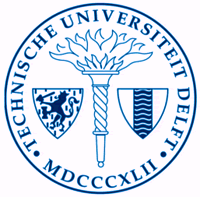
Delft University of Technology (Dutch: Technische Universiteit Delft), also known as TU Delft, is the largest and oldest Dutch public technical
university, located in Delft,
Netherlands, sometimes popularly called Holland. With eight faculties and numerous research institutes it hosts over 19,000 students (undergraduate and postgraduate), more than 3,300 scientists and more than 2,200 people in the support and management staff.
The university was established on January 8, 1842 by King William II of the Netherlands as a Royal Academy, with the main purpose of training civil servants for the Dutch East Indies. The school rapidly expanded its research and
education curriculum, becoming first a Polytechnic
School in 1864, Institute of Technology in 1905, gaining full university rights, and finally changing its name to Delft University of Technology in 1986.
Dutch Nobel laureates Jacobus Henricus van 't Hoff, Heike Kamerlingh Onnes, and Simon van der Meer have been associated with TU Delft. TU Delft is a member of several
university federations including the IDEA League, CESAER, UNITECH, and 3TU.
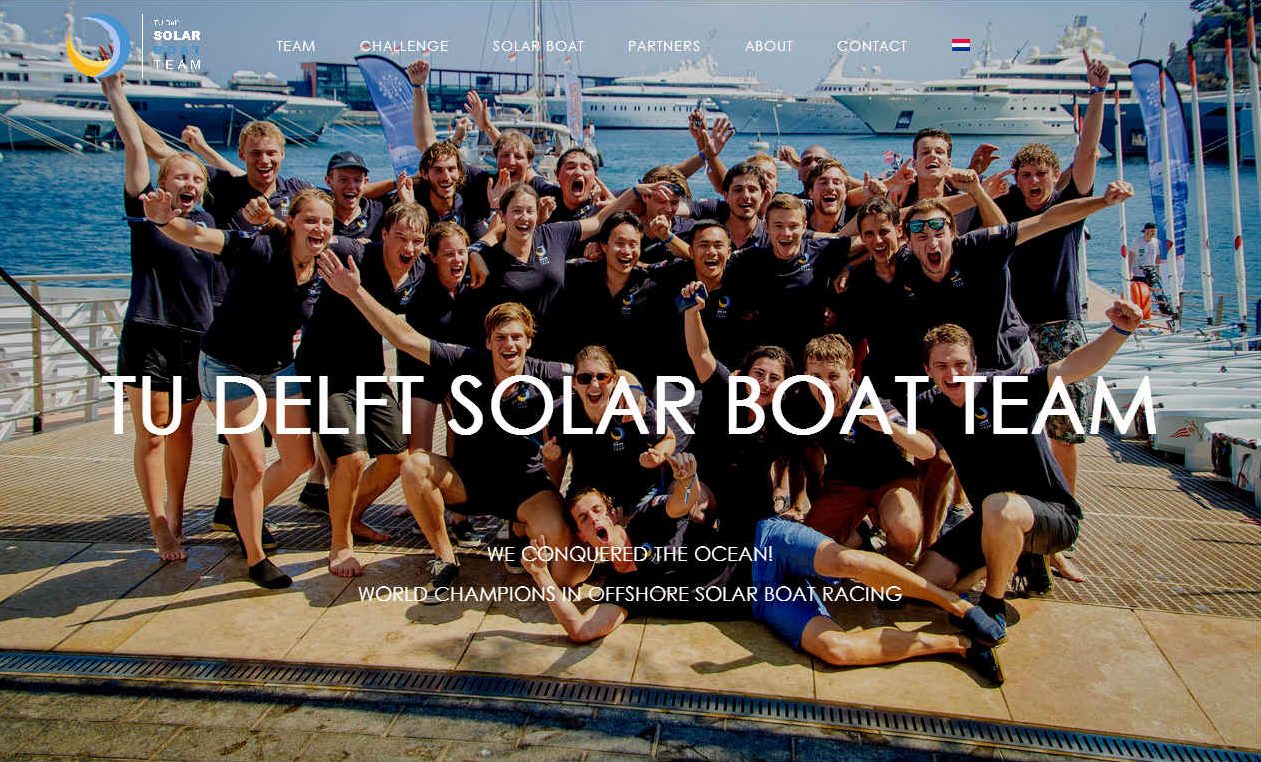
MONACO
JULY 2019 - TU
DELFT SOLAR BOAT TEAM WORLD CHAMPION SOLAR BOAT RACING ON OPEN SEA
During the Solar & Energy Boat Challenge 2019, the TU Delft Solar
Boat Team has become world champion solar boat racing on the open sea.
Last Friday, July 5 and Saturday, July 6, four teams competed in Monaco
for the world title. The Delft students participated in the offshore
class for the first time in the team's history, making them the first
Dutch team to race on the open sea with a solar boat.
The
TU Delft Solar Boat 2019 is the first to finish during the Monaco
Offshore Challenge 2019.
Solar energy on the open sea
After
several setbacks, such as a hydrofoil which broke off during the last
tests for Monaco on the IJsselmeer and a problem with the electrical
system around the solar panels, the team managed to become the world
champion. The TU Delft Solar Boat Team, which consists entirely of
students, wants to show that solar energy can also control the open sea.
Kristian Ruiter, team manager, explains: “After all the setbacks, I
would not have dared to dream that we would eventually become world
champions. I am extremely proud of the team that we have continued
despite everything and that this is ultimately rewarded with this
fantastic result. ”
Speed
record
The
racing days were a huge emotional roller coaster for the team. On Friday
the first race took place between Monaco and Ventimiglia (IT) and was a
distance of 30 km. Ruiter explains: "Due to excellent
circumstances, a team that worked very well together and a perfectly
functioning boat, we were able to achieve very high speeds and even set
a speed record for the boat
at a speed of 35 km / h."
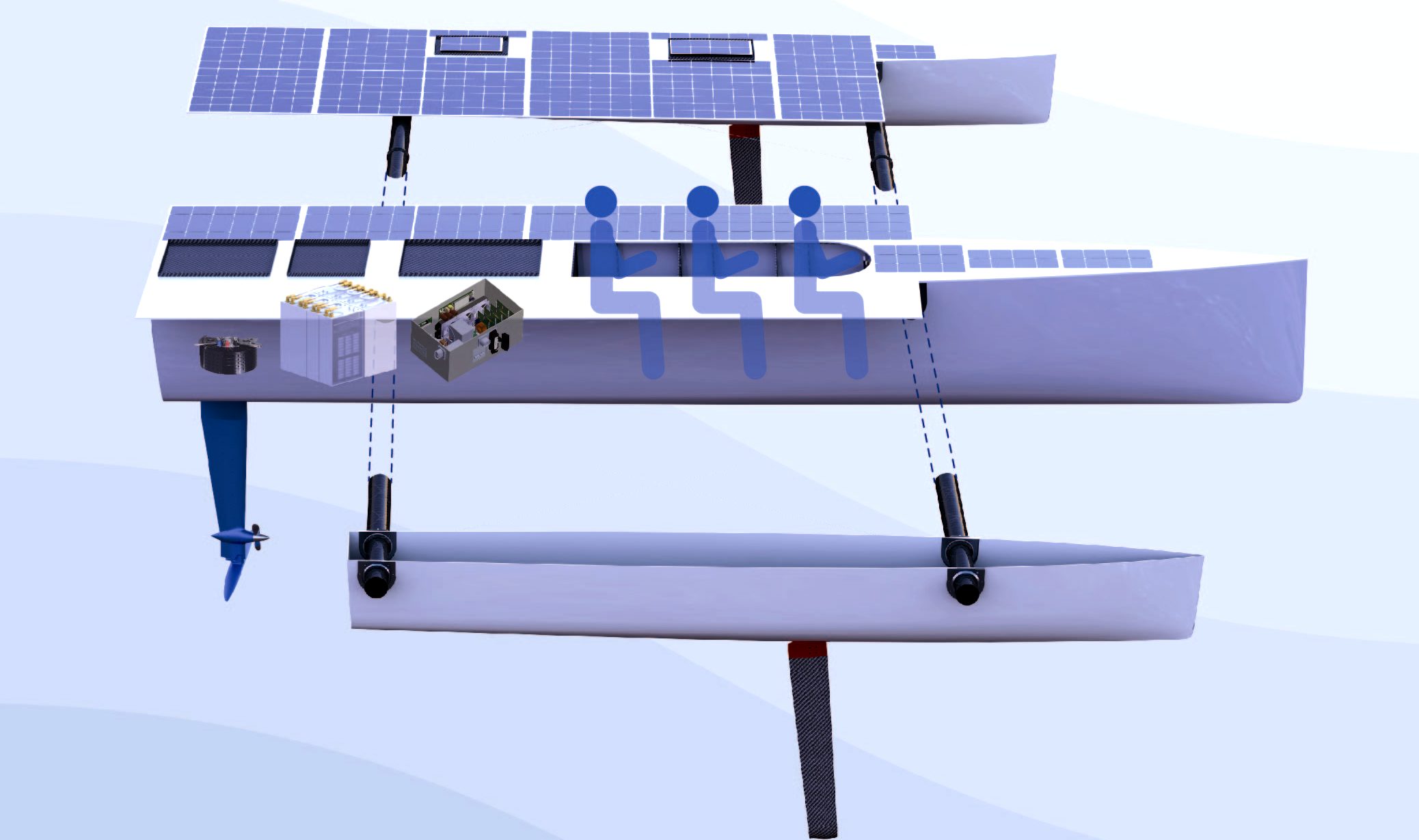
Damage
to electronic system
After
the successful completion of the long-distance race on Friday, the team
discovered damage to the electrical system around the solar panels.
Olmar van Beurden, chief electronics,
explains: “The damage was caused by internal heat. Unfortunately, this
damage could not be fully repaired for the next race on Saturday. To
ensure that the boat was no longer damaged, and to ensure the safety of
the pilots, we decided to remove the solar
panels from our boat and sail the Saturday race on the energy stored
in the boat's batteries.
Strategic
challenge
The
60 km long-distance race that took place on Saturday was a major
challenge for the team. “The solar panels were no longer on the deck,
so we had to deal with the energy
that was already stored in the batteries. This resulted in lower speeds
and a major strategic challenge to match consumption and battery
capacity. Nevertheless, I am extremely proud of our team that we have
become world champions by sailing efficiently and putting everything in
place, ”says Ruiter. The team crossed the finish line almost twice as
fast as the competition, which had to recharge on the way.
The
TU Delft Solar Boat Team
The
TU Delft Solar Boat Team consists of 28 students from ten different
faculties at TU Delft. In one year, the students of the team go through
the process of designing, producing, testing and finally racing with a
solar boat. Since its foundation in 2005, the TU Delft Solar Boat Team
has been trying to inspire the maritime sector to sail with fewer
emissions. Until last year the students did this by participating in
races for inland waterway solar boats. With this they have shown what a
student team can achieve through the use of solar
energy. This is the first year that the team takes on the offshore
challenge. De Ruiter: "In this way we show the maritime industry
that there can also be sailed on the open sea with fewer emissions"
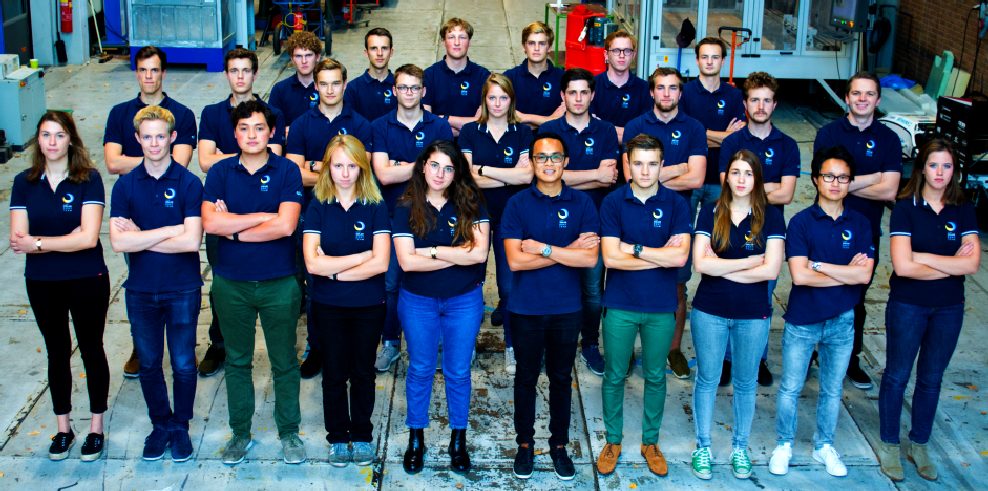
MONACO
JULY 2019 - TU DELFT SOLAR BOAT
TEAM WERELDKAMPIOEN ZONNEBOOT RACEN OP OPEN ZEE
Het TU Delft Solar Boat Team is tijdens de Solar & Energy Boat
Challenge 2019 wereldkampioen zonneboot racen op open zee geworden.
Afgelopen vrijdag 5- en zaterdag 6 juli streden vier teams in Monaco om
de wereldtitel. De Delftse studenten hebben voor het eerst in de
geschiedenis van het team meegedaan aan de offshore class en zijn
daarmee het eerste Nederlandse team dat met een zonneboot op open zee
heeft geracet.
De TU Delft
Solar Boat 2019 finisht als eerste tijdens de Monaco Offshore Challenge
2019.
Zonne energie op de open zee
Na meerdere tegenslagen, zoals een draagvleugel wat tijdens de laatste
tests voor Monaco op het IJsselmeer afbrak en een probleem met het
elektrisch systeem rondom de zonnepanelen, heeft het team het toch voor
elkaar gekregen om wereldkampioen te worden. Het TU Delft Solar Boat
Team, dat volledig bestaat uit studenten, wilt hiermee laten zien dat
zonne-energie ook de open zee de baas kan zijn. Kristian Ruiter,
teammanager, vertelt: “Ik had na alle tegenslagen niet durven dromen
dat we uiteindelijk wereldkampioen zijn geworden. Ik ben enorm trots op
het team dat we ondanks alles door hebben gezet en dat dit uiteindelijk
wordt beloond met dit fantastisch resultaat.”
Snelheidsrecord
De racedagen waren een enorme emotionele rollercoaster voor het team. Op
vrijdag vond de eerste race plaats tussen Monaco en Ventimiglia(IT) en
bedroeg een afstand van 30 km. Ruiter vertelt: “Door uitstekende
omstandigheden, een team dat heel goed samen werkte en perfect
functionerende boot, hebben we erg hoge snelheden kunnen behalen en
zelfs een snelheidsrecord voor de boot kunnen neerzetten met een
snelheid 35 km/u.”
Schade aan
elektronisch systeem
Na het succesvol uitvaren van de langeafstands-race op vrijdag, heeft
het team schade ontdekt aan het elektrische systeem rondom de
zonnepanelen. Olmar van Beurden, chief elektronica, legt uit: “De
schade is ontstaan door interne hitte. Helaas kon deze schade niet meer
volledig hersteld worden voor de volgende race op zaterdag. Om er zeker
van te zijn dat er niet meer schade ontstond aan de boot, en om de
veiligheid van de piloten te garanderen, besloten we de zonnepanelen van
onze boot te verwijderen en de race van zaterdag te varen op de energie
die was opgeslagen in de batterijen.
Strategische
uitdaging
De langeafstandsrace van 60 km die op zaterdag plaatsvond was voor het
team een grote uitdaging. “De zonnepanelen zaten niet meer op het dek
en dus moesten we het doen met de energie die al was opgeslagen in de
batterijen. Dit resulteerde in lagere snelheden en een grote
strategische uitdaging om het verbruik en de batterijcapaciteit te laten
matchen. Desondanks ben ik enorm trots op ons team dat we door efficiënt
te varen en alles op alles te zetten, wereldkampioen zijn geworden”,
zegt Ruiter. Het team kwam bijna twee keer zo snel over de finish dan de
competitie, die onderweg nog moesten opladen.
Het
TU Delft Solar Boat Team - Het TU Delft Solar Boat Team bestaat uit
28 studenten van tien verschillende faculteiten aan de TU Delft. In één
jaar tijd doorlopen de studenten van het team het proces van ontwerpen,
produceren, testen en tenslotte racen met een zonneboot. Sinds de
oprichting in 2005 probeert het TU Delft Solar Boat Team de maritieme
sector te inspireren om met minder uitstoot te varen. Tot en met
afgelopen jaar deden de studenten dit door deel te nemen aan races voor
zonneboten op binnenwateren. Hiermee hebben ze laten zien wat een
studententeam kan bereiken door het gebruik van zonne-energie. Dit is
het eerste jaar dat het team de offshore uitdaging aan gaat. De Ruiter:
”Zo laten we aan de maritieme industrie zien dat er ook op open zee
met minder uitstoot gevaren kan worden”
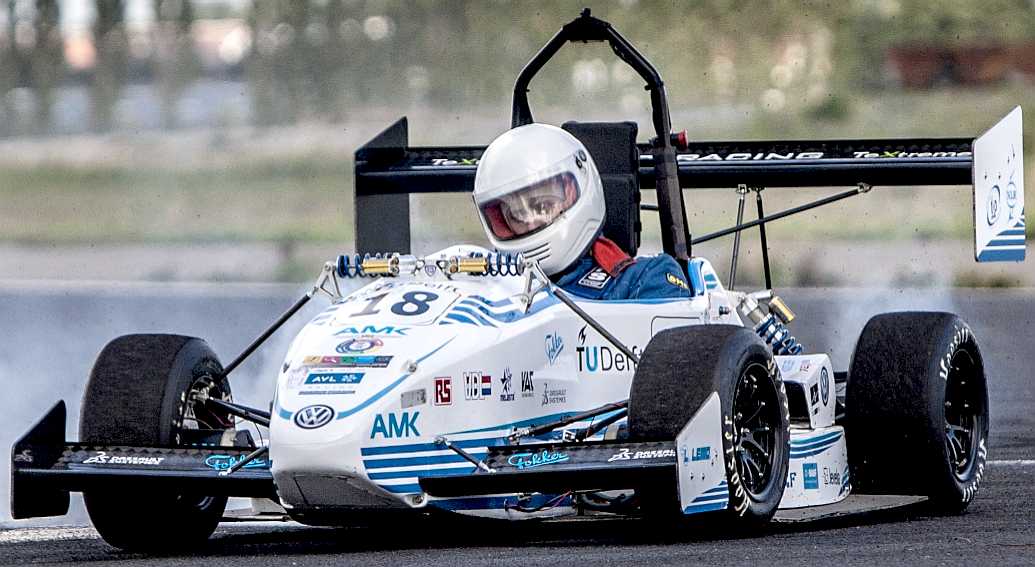
FORMULA
STUDENT
Formula Student is a student engineering competition held annually in the
UK. Student teams from around the world design, build, test, and race a small-scale formula style racing car. The cars are judged on a number of criteria as listed below. It is run by the Institution of Mechanical Engineers and uses the same rules as the original Formula SAE with supplementary regulations.
The 2014 Formula Student event was held at Silverstone Circuit between the 9th and 14th July 2014.
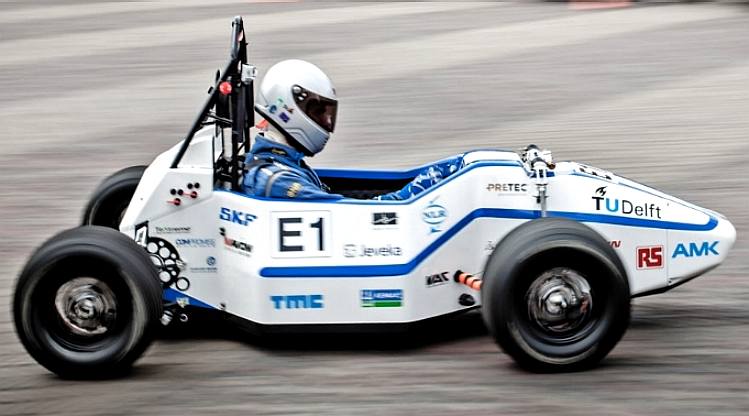
The DUT12 is the second electric car of the DUT Racing team. The biggest difference compared to the DUT11 is the four-wheel-drive system introduced this year. This makes it possible to use the brake energy from all wheels to power the motors which results in higher efficiency. In the DUT12 the batteries are no longer placed behind the driver, but on both sides alongside the driver for better handling. Prepregs have been used to produce the
monocoque, saving weight compared to the previous car.
NUNA
SOLAR CAR - DUT ELECTRIC RACING
Delft University of Technology Racing team, trading as DUT Racing or Formula Student Team Delft, is a Dutch Formula Student team based in Delft. DUT Racing is known for constructing lightweight Formula Student racing cars and has been competing in the global Formula Student competition for over a decade. Having won Formula Student UK twice (2011, 2014) and Formula Student
Germany five times (2008, 2010, 2011, 2012, 2013), DUT Racing is one of the top teams competing in Formula Student at the moment.
After
years of loud, fuel burning machines, the competition changed and so did
DUT Racing. With the introduction of an electric class in 2010 at the
Formula Student UK and Formula Student Germany competition, several
top-level teams made the switch to the new power source. The performance
showed by the electric cars in the 2010 season, made the DUT Racing team
change to the new class in 2011. Not only did the performance play a
part in the decision, the challenge of redesigning almost every part of
the car and thus challenging the students in their engineering
capability also played a big role in the switch to electrically powered
cars. And with success: 2011 is the most successful season for the team
up until now. With the DUT11, the team won both the UK and Germany
event.
The
DUT12 was the second electric car of the DUT Racing team. The biggest
difference compared to the DUT11 was the four-wheel drive system. This
made it possible to use the brake energy from all wheels to recharge the
batteries, thus making the car more efficient. With a second place at Formula
Student UK and another win at Formula Student Germany,
the electric drive was again proving successful. With a time of 3,45
seconds on the acceleration test (0-75 meter), the car set the quickest
acceleration time by a Formula Student race car. The time was beaten by
the ETH
Zurich car (0-75m in 3,210s) at the Formula
SAE Italy competition in September 2013. Later on, in September
2013, the DUT12 would set a Guinness
World Record for acceleration of an electric car, by reaching 100 km/h
in 2.13 seconds. This time was beaten by the ETH
Zurich car in November 2014 when it accelerated to 100 km/h in 1.785
seconds.
In
2013, the DUT13 got an aerodynamics package, something the team up until
then had never experimented with. Featuring 4-wheel drive, the car now
also disposed of a front wing, rear wing and undertray, significantly
improving the traction of the car. Additionally, part of the electronics
were changed, improving the traction control features and yaw rate
controllers. The team won again the Formula Student competition in
Germany, and placed second in the competition in Austria.
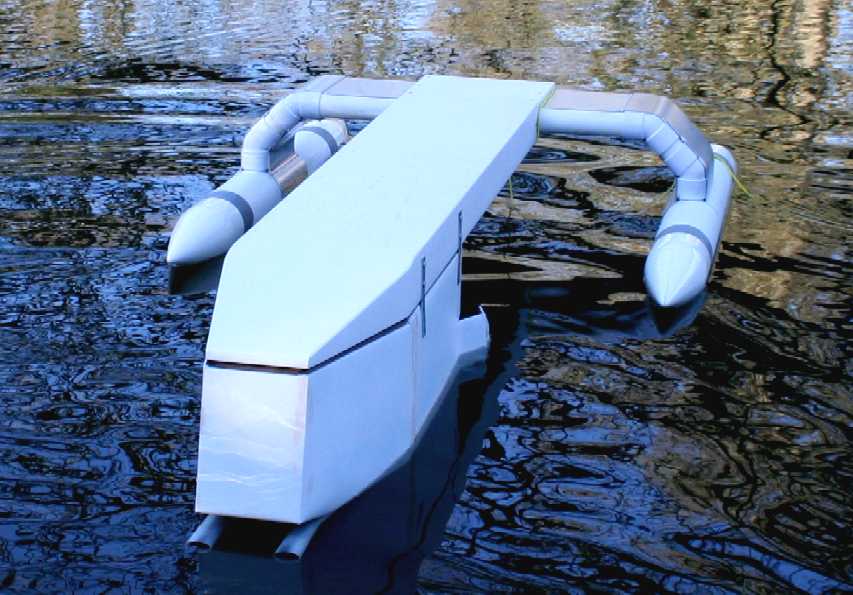
GB
PATENT GRANTED JUNE 2019 - This 'proof of concept' model robot boat is capable of sucking up plastic
waste from a body of water, first shredding solids as necessary. A full
size version is designed to go out into the ocean gyres and hunt down the
floating garbage dumps. It is not a competitor to Boyan Slat's passive
system, it is a much needed additional tool in the fight to keep oceans
clean and fish stocks healthy. The boat is solar and wind powered, hence
autonomous, it is also designed to be used unmanned for the main part,
or drone controlled for certain conditions of operation, such as
rescuing animals caught in fishing nets.
A
high speed version of this robot
ship based on a SWASH
hull would use no diesel fuel to monitor the oceans autonomously at relatively high
speeds 24/7 and 365 days a year - only possible with the revolutionary energy harvesting system.
A modular hullform is adaptable for automatic release and recovery of UAVs,
ROVs
or towed arrays, alternating between drone and fully autonomous modes.
This vessel could pay for itself in fuel saved every ten years.
BOYAN
SLAT - DAILY MAIL SEPTEMBER 2013 by Sarah Griffiths
Could a teenager save the world's oceans? Student, 19, claims his invention could clean up the seas in just five years:
* Device could remove 20 billion tonnes of plastic from the world's oceans
* Boyan Slat came up with the idea of a series of floating booms and processing platforms designed to 'suck' in floating plastic rubbish
* The young engineering student's 'ocean cleanup' concept is designed to be self sufficient and harness energy from the sun and waves
* His invention could even make money by selling the plastic collected from the oceans, which kills millions of animals every year
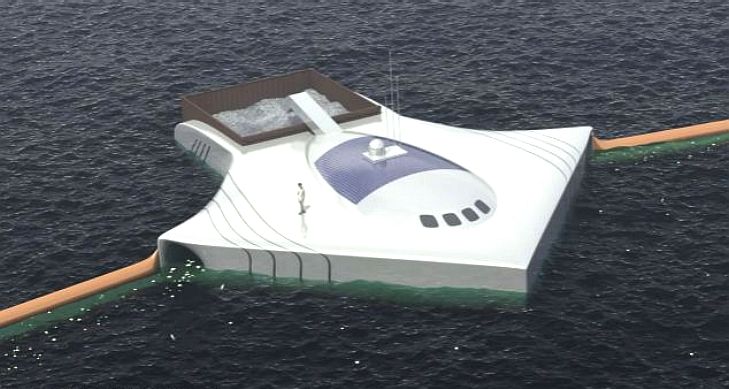
A Dutch teenager has invented a device that he claims could clean up some 20 billion tonnes of plastic waste from the world's oceans.
Boyan
Slat, 19, came up with the idea of a series of floating booms and processing platforms designed to collect floating plastic rubbish.
The 'ocean cleanup' concept is designed to capture the floating plastic but allow life like fish and
plankton to pass through unharmed, while saving the waste materials to be recycled.
The engineering student believes that once operational, his device could dramatically reduce the amount of rubbish in the oceans in just five years time.
Millions of tonnes of plastic debris are littering oceans and have accumulated in areas of high concentration called
gyres - which are essentially floating rubbish tips.
While he believes humans must end their reliance on disposable plastic items and manage waste responsibly, his innovation could make a big difference to the cleanliness of oceans in the shorter-term.
He proposes fixing sea
water processors to the sea bed, which are also attached to the floating platform so that the water can move through them and generate energy.
His concept also includes using floating booms instead of nets to cover vast areas of water effectively, while no mesh and a very low speed, means there will be 'virtually no by-catch' and unfortunate animals getting tangled in nets that are meant to help conserve their habitat.
Writing on his website, Mr Slat said: 'Although this hypothesis still has to be tested, even the planktonic species - due to their density being close to that of the sea water - may move under the booms along with the water flow.'
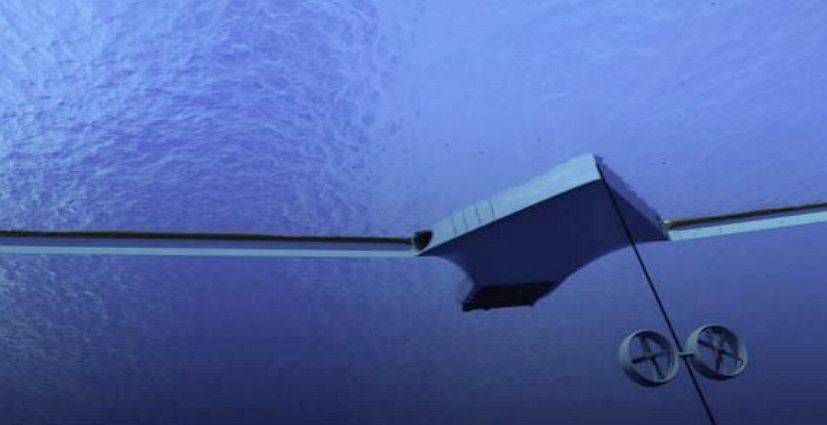
In a bid to solve problems of conventional clean-up measures, including rubbish escaping, emissions and high costs, he said his contraptions are 'completely self-supportive' and get their energy from the sun and waves.
'By letting the platforms' wings sway like an actual
manta
ray, we can ensure contacts of the inlets with the surface, even in the roughest weather,' he said.
As well as solving an environmental problem, Mr Slat also believes his invention could make up to $500 million a year from recycling the waste collected.
He said: 'This concept is so efficient, that we estimate that by selling the plastic retrieved from the 5 gyres, we would make in fact more money than the plan would cost to execute. In other words; it may potentially be profitable.'
Mr Slat believes that many people need reminding about the environmental disaster affecting the Earth's oceans.
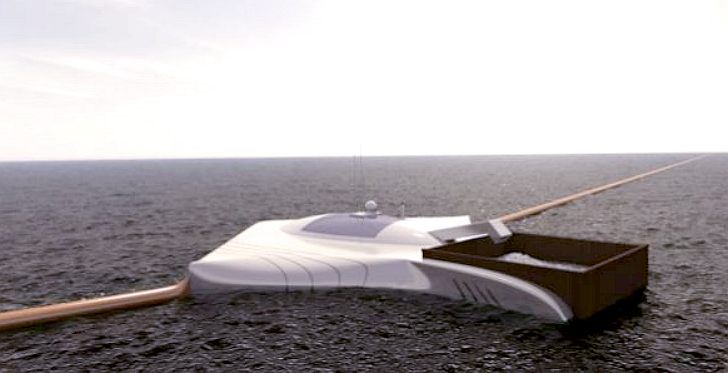
He said: 'One of the problems with preventive work is that there isn’t any imagery of these ‘garbage patches’ because the debris is dispersed over millions of square
kilometres.'
'By placing our arrays however, it will accumulate along the booms, making it suddenly possible to actually visualise the oceanic garbage patches. We need to stress the importance of recycling, and reducing our consumption of
plastic
packaging,'
VR-zone reported.
While Mr Slat is now a student at the Delft University of Technology, he came up with the idea while he as at school to win a number of prizes and the respect of more experiences marine experts.
He has now set up The Ocean Cleanup Foundation to raise funds to develop his innovation.
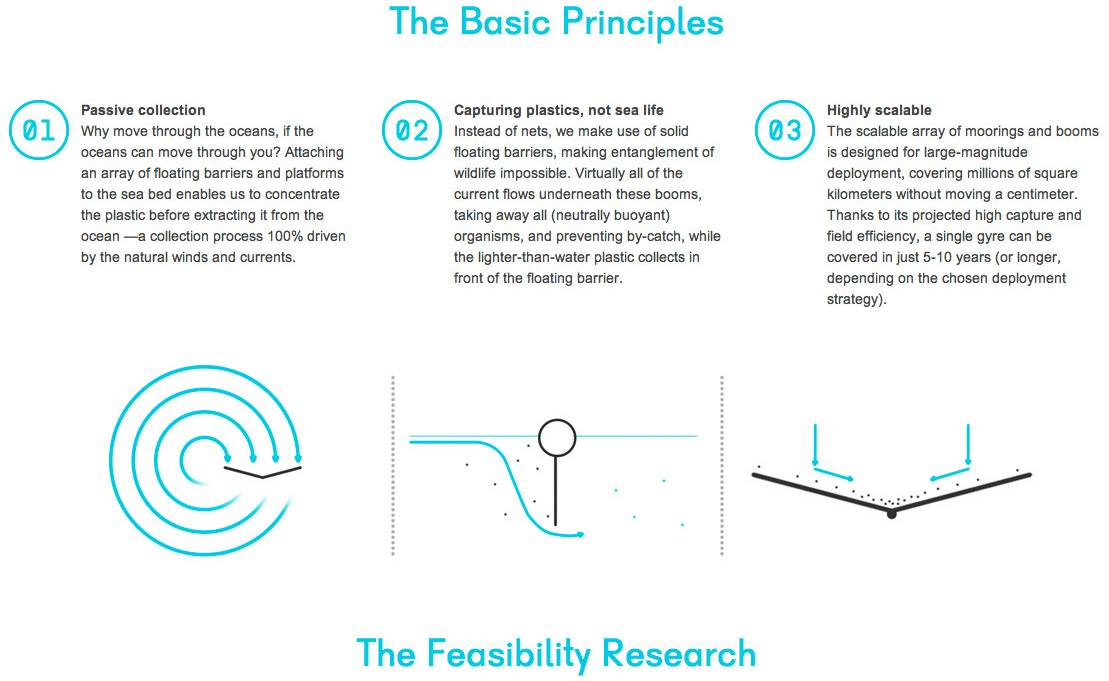
HOW DOES IT WORK
- The Ocean Cleanup Array is an anchored network of floating booms and processing platforms will span the radius of a gyre.
The booms act as giant funnels where the angle of the booms effectively 'suck' rubbish in.
The debris enters the platforms, where it will be filtered out of the water and eventually stored in containers until collected for recycling on land.
One of the most significant advantages of using booms instead of nets is that marine life cannot be caught in them.
Furthermore, because the transport of plastic along the booms is driven by the currents, it’s slow enough for organisms to escape.
SHIPS
WIND ENERGY - BSc
MARINE TECHNOLOGY
Are
you fascinated by ports? Do you love to watch a big container ship as it
sails by? When you’re on the beach, is your gaze drawn to the drilling
rigs further out at sea? In other words, if you feel inspired by ships
and shipping then the Bachelor’s programme in Maritime Engineering is
the right way to turn your passion into your profession.
Inland
vessels, mega-tankers and container ships full of goods and raw
materials travel the world, from China to Africa,
from South-America to India, along the rivers of Europe. Shipping is
indispensable, as are well-trained maritime engineers. And of course
Maritime Engineering is all about shipbuilding.
A big ship is almost like a small village and you learn to design a ship
with all the necessary features and facilities. But a maritime engineer
has many other skills as well. Drilling platforms, shipping companies,
shipping routes, insurance, oil and gas transport, offshore
installations, pipeline and cable layers and heavy transport: it all
forms part of Maritime Engineering.
At
the top
When
it comes to maritime engineering the Netherlands has an outstanding
position in the international league for shipbuilding yards, with
commissions for top-quality tankers,
naval vessels and luxury motor and sailing yachts. At TU Delft you will
really get to know this sector: lecturers who work in the profession
will tell you all about the latest developments and experts from the
commercial sector are regular guests. And since we are a small degree
programme, you will know most of your fellow students by their names and
nicknames and will enjoy good contacts with the lecturers. Moreover, TU
Delft’s degree programme in Maritime Engineering is unique in the
Netherlands – it’s the only maritime engineering programme at
university level.
Degree
programme
To
begin with you will follow a broad-based Bachelor's
degree programme lasting 3 years. In all years you will take
maritime subjects such as Maritime Operations, Hydromechanics, Ship
Production and Ship Construction. You can expect some fairly challenging
mathematics and physics as well. And to ensure that you don’t get a
one-sided technical training, you will also study aspects of economics,
philosophy, sustainability, environment and management.
You
will learn to put your acquired knowledge into practice. In the first
year you will be given the task of designing, building and
demonstrating a floating hoist construction made from just a steel
plate, piping and wire. Moreover, during your first year you will go on
a short internship that will get you acquainted with the technical, organizational
and social aspects of a maritime enterprise.
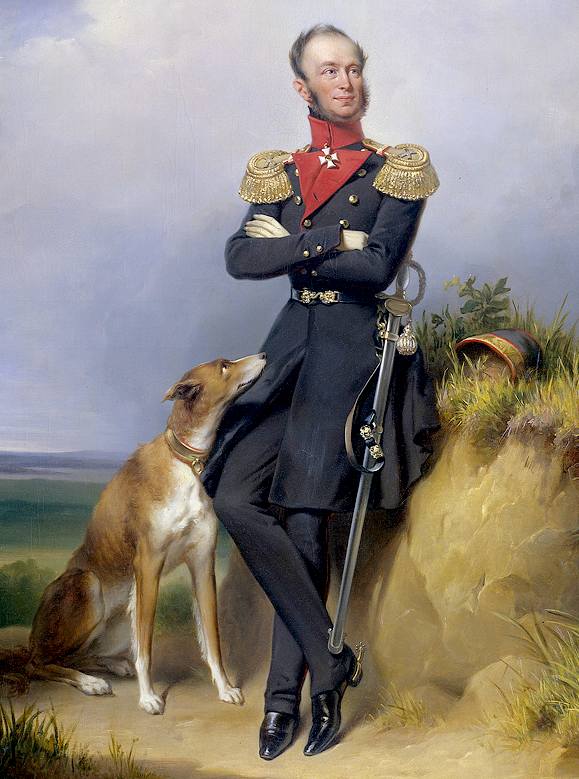
William II (Willem Frederik George Lodewijk van Oranje-Nassau) (6 December 1792 – 17 March 1849) was King of the Netherlands, Grand Duke of Luxembourg, and Duke of Limburg from 7 October 1840 until his death in 1849.
MECHANICAL,
MARITIME & MATERIALS ENGINEERING - PROFESSORS A - Z
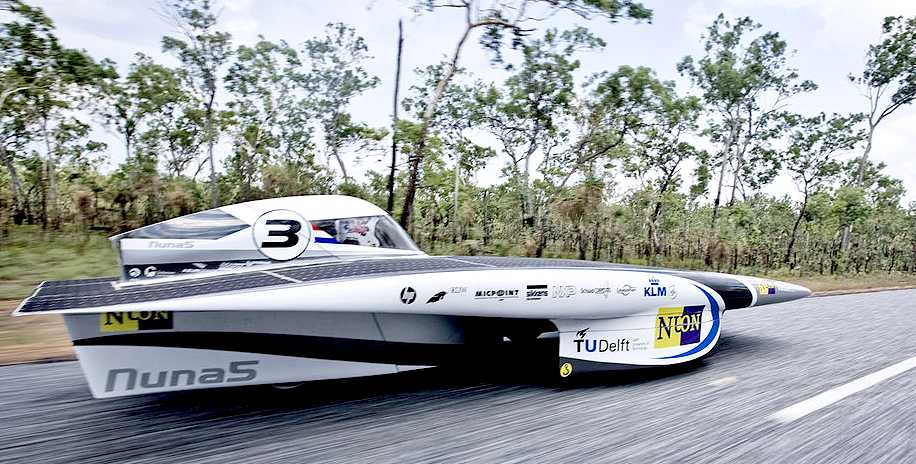
NUNA
5 - Nuna is the name of a series of manned solar powered race cars that won the World solar challenge in Australia five times, of which four times in a row: in 2001
(Nuna 1 or just Nuna), 2003 (Nuna 2), 2005 (Nuna 3), 2007 (Nuna 4) and 2013
(Nuna 7). The Nunas are built by students who are part of the Nuon Solar Team at the Delft University of Technology in the Netherlands.
"Nuna" is also the Icelandic word "now."
RESEARCH
TU Delft researchers developed many new technologies used today, including Glare, a Fibre Metal Laminate used in Airbus A380 skin and Vision in Product Design design method. Cees Dekker's lab at TU Delft demonstrated in 1998 the first transistor made out of single nanotube molecule. Delta Works plan was, in part, a child of TU Delft graduates, including Johan Ringers and Victor de Blocq van Kuffeler. TU Delft was a precursor of Open design concept.
In architecture, TU Delft is famous for Traditionalist School in Dutch architecture. TU Delft was a home to many prominent microbiologists including Martinus Beijerinck, who in 1898 discovered viruses while working at TU Delft, and Albert Jan Kluyver, father of comparative microbiology, which resulted in the creation of so-called Delft School of Microbiology.
Some recent projects being developed at the university include Flame, first
humanoid robot possessing the ability to walk as humans, Superbus, project aiming to design a high speed bus reaching top speeds of 250 km/h, Nuna, solar-powered race car and four times winner of the World Solar Challenge, DUT Racing, electrical Formula Student project having won multiple competitions and holding the current Guinness World Record for fastest accelerating electric vehicle, DelFly, Micro air vehicle and the smallest ornithopter so far fitted with a camera, Fhybrid, world's first hydrogen-powered scooter, Tribler, an open source peer-to-peer client with online TV functionalities, Delfi-C3, CubeSat satellite constructed by TU Delft students, and the Delfi-n3Xt launched 21 October 2013, Forze, hydrogen
fuel
cell-powered racing car, Eco-Runner vehicle participating in Eco-marathon, Stratos II, a sounding rocket developed by Delft Aerospace Rocket Engineering which is to set the European altitude record achieved by amateur rockets at 50 km in September/October 2014, as well as The Ocean Cleanup, a project aimed at developing a method of cleaning up the oceanic garbage patches.

NUNA
7 EVOLUTION - The main changes to the Nuna 5 from its predecessor the Nuna 4 was the diminished battery weight, changing from 30 kg in 2007 to 25 kg.Other changes required cars not be allowed to race on previously used slicks (smooth tires), instead requiring profiled (treaded or grooved) tires. Also, the driver was required to sit more upright with a seating angle of, at most, 27 degrees. It finished second.
The changes to the Nuna 6 from its predecessor is the change of solar cells to Monocrystalline silicon cells in accordance with the new rules for the World solar challenge. Also the weight of the batteries has been reduced in accordance with the rules. To improve performance the weight of the car and aerodynamic drag have been reduced
The main change to the Nuna 7 from its predecessors is that it has four wheels instead of three, as required by the new rules of the World solar challenge. The vehicle is also asymmetric, as the driver's cabin is on the right side. The weight of the batteries and vehicle are barely changed with respect to its predecessor, Nuna 6. Nuna 7 won the 2013 Bridgestone World Solar Challenge.
DELFT
MODERN HISTORY
After the end of the
Second World
War, TU Delft increased its rapid academic expansion. Studium Generale was established at all universities in the Netherlands, including TU Delft, to promote a free and accessible knowledge related to culture, technology, society and science. Because of the increasing number of students, in 1974 the first Reception Week for First Year Students (Ontvangst Week voor Eerstejaar Studenten, OWEE) was established, which became a TU Delft tradition since then.
On September 1, 1986, the Delft Institute of Technology officially changed its name to Delft University of Technology, underlining the quality of the education and research provided by the institution. In the course of further expansion, in 1987 Delft Top
Tech institute was established, which provided a professional master education in management for people working in the technology-related companies. On September 1, 1997, the 13 faculties of the TU Delft were merged into 9, to improve the management efficiency of the growing university. In the early 1990s, because the vast majority of the students of the university were male, an initiative to increase the number female students resulted in founding a separate emancipation commission. As a result Girls Study Technology (Meiden studeren techniek) days were established. In later years the responsibilities of the commission were distributed over multiple institutes.
Since 2006 all buildings of the university are located outside of the historical city center of Delft. Relatively new building of Material Sciences department was sold, later demolished in 2007 to give place for a newly built building of the Haagse Hogeschool. Closer cooperation between TU Delft and Dutch universities of applied sciences resulted in physical transition of some of the institutes from outside to Delft. In September 2009 many institutes of applied sciences from the Hague region as well as Institute of Applied Sciences in Rijswijk, transferred to Delft, close to the location of the university, at the square between Rotterdamseweg street and Leeghwaterstraat street.
On May 13, 2008, the building of the Faculty of Architecture was destroyed by fire, presumably caused by a short circuit in a coffee machine due to a ruptured water pipe. Luckily, the architecture library, containing several thousands of books and maps, as well as many architecture models, including chairs by Gerrit Rietveld and Le Corbusier, were saved. The Faculty of Architecture is currently housed in the university's former main building.
In 2007 the three Dutch technical universities, TU Delft, TU Eindhoven and University of Twente, established a federation, called 3TU.
TU
DELFT CONTACTS
Postbus 5
2600 AA Delft
The Netherlands
T: +31 (0)15 27 89111
E: info@tudelft.nl
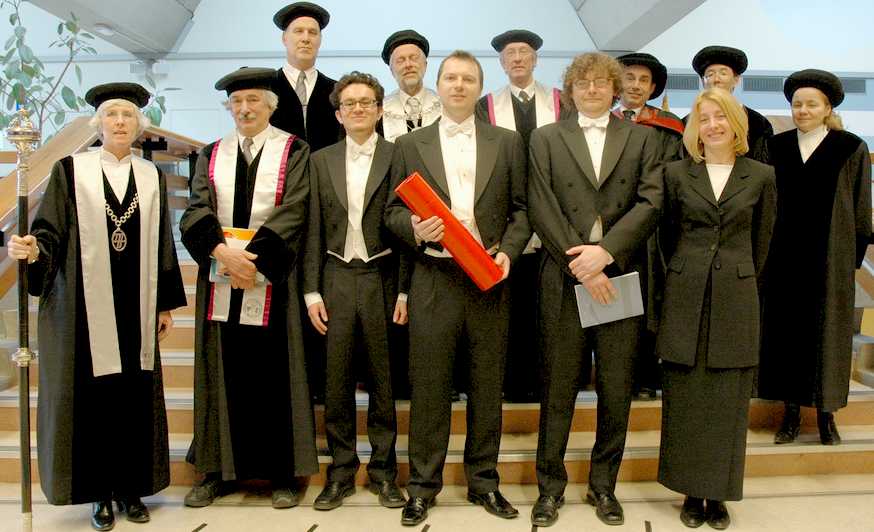
Typical photo following a TU Delft doctoral defense. The Promovendus (center) is accompanied by two Paranymphs. Madame Bedel is on the left, holding the staff. The red tube holds the doctoral diploma. The Promovendus, as well as the Paranymphs must wear white ties, while all professors in the defense committee wear togas.
FREE
SOFTWARE - SHIPSHAPE

CONTACTS
TU Delft
Postbus 5
2600 AA Delft
The Netherlands
T: +31 (0)15 27 89111
E: info@tudelft.nl
W:
http://www.tudelft.nl/en/
MARINE
ACADEMIC INSTITUTIONS A-Z
Australian
Maritime - Geneve
- Hawaii
Renewable - NERC
- Newcastle
Naval
NOC
Oceanographic - Plymouth - Portsmouth
- Seoul
Naval - SOTON
Strathclyde
Marine - Sussex
- TU
Delft - USP South
Pacific - Webb
Institute
LINKS
& REFERENCE
http://www.southampton.ac.uk/
Wikipedia
University_of_Southampton
Wolfson_Unit_Marine_Technology
Wikipedia
Delft DUT12
Wikipedia
DUT_Racing
Wikipedia
Formula_Student
Wikipedia
Nuna
http://en.wikipedia.org/wiki/Nuna
http://www.southampton.ac.uk/
http://en.wikipedia.org/wiki/University_of_Southampton
http://www.wumtia.soton.ac.uk/
http://www.mbapolymers.com/home/news-cleaning-ocean-plastic
MBA
polymers
news-cleaning-ocean-plastic
http://auvac.org/community-information/community-news/view/935
http://noc.ac.uk/
http://noc.ac.uk/sbri
Oceanology
International OI China 2014 Conference Programme Remote Technology
Underwater Kevin Forshaw
NOC
robot vehicles launched from Plymouth-on fish tracking mission
NOC
research at sea mars
Daily
Mail Boyan-Slat-19-claims-invention-clean-worlds-oceans-just-years
http://www.dailymail.co.uk/sciencetech/article-2415889/Boyan-Slat-19-claims-invention-clean-worlds-oceans-just-years.html
http://www.asvglobal.com/latest-news/first-sea-lord-opens-new-asv-facility
http://noc.ac.uk/news/robot-vehicles-launched-from-plymouth-morning-fish-tracking-mission
http://noc.ac.uk/research-at-sea/nmfss/mars
http://www.msubs.com/
http://www.xylemanalytics.co.uk/index.php
http://www.amc.edu.au/
http://www.gavia.is/
http://en.wikipedia.org/wiki/DUT12
http://en.wikipedia.org/wiki/DUT_Racing
http://en.wikipedia.org/wiki/Formula_Student
http://www.strath.ac.uk/na-me/
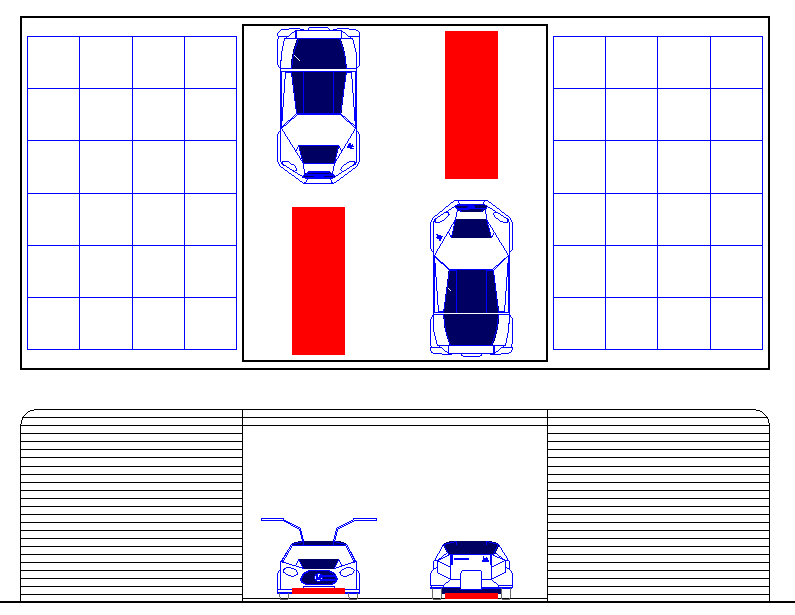
The
ECOSTAR
BE4 is shown here to scale alongside a universal Bluebird™ energy
cartridge of the form suitable for most supermini city cars of today. The
Ecostar is a very small and low sports car. Whereas, the service station is
designed to accommodate large vans. These drawings are to give you some idea of
the size plot of land that is needed. The example service station is shown here
with solar panels on the roof. There would be nothing to stop an operator from
having other buildings and land with more solar panels to harvest renewable
energy. In addition, a service station like this is a load-leveling device for
power generating stations that are on tickover between peaks. You might ask why
then, that there are currently no utilities looking at this project? The reason
is that coal is much
cheaper for them to burn, regardless of climate change - and there is nothing to
stop them doing so. Because, 2030 Euro targets are not binding on member states.
Check out the report by Business
Monitor International.
|















